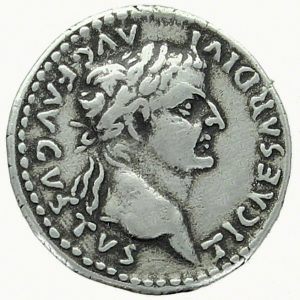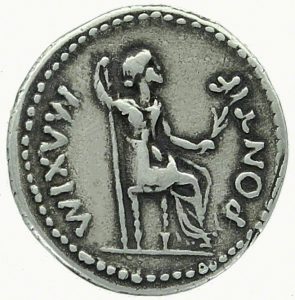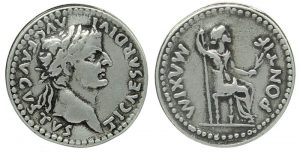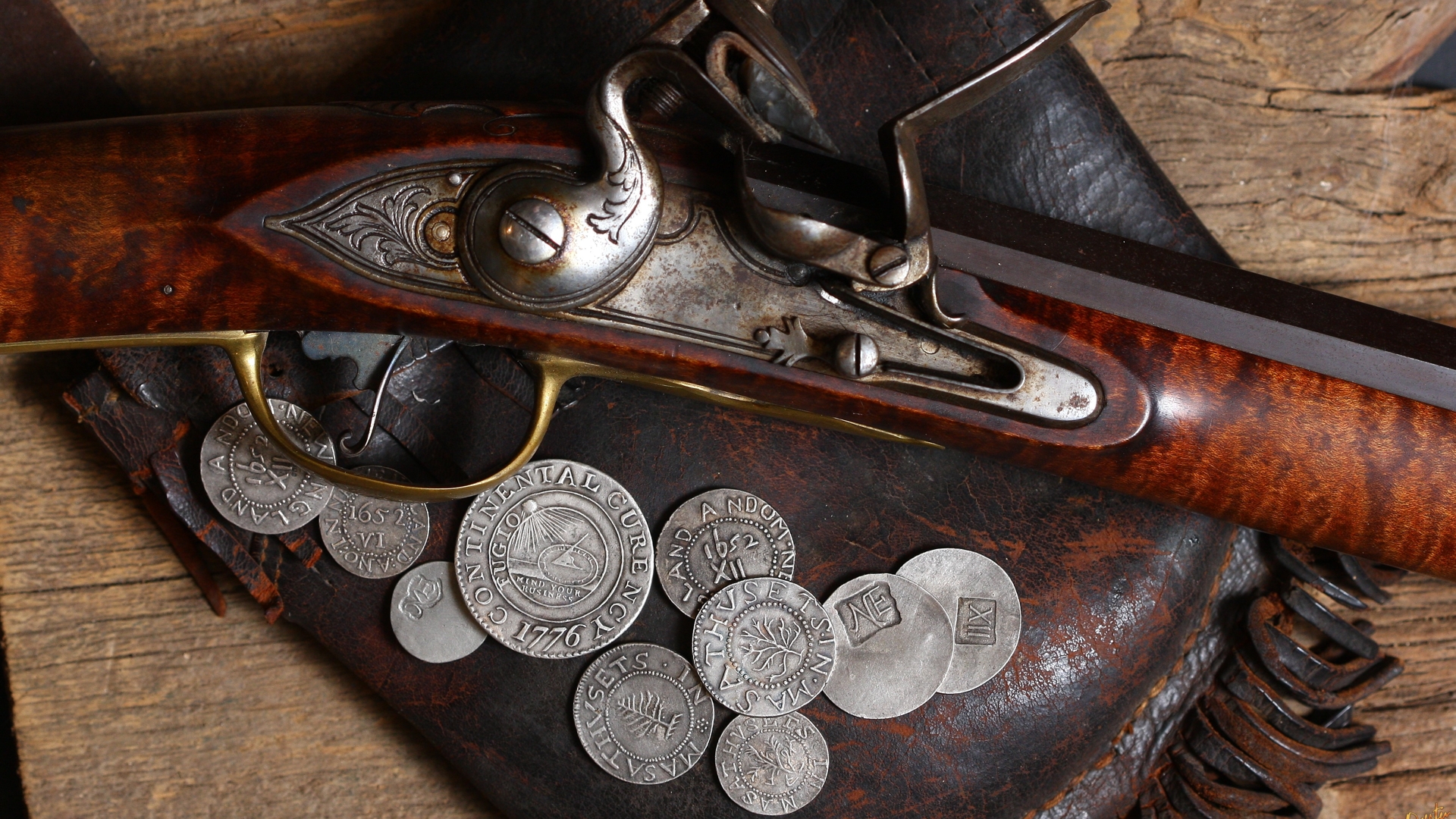Tiberius Denarius – Tribute Penny Coin
Tiberius’ silver denarius is a historically significant silver coin minted during the time of Jesus Christ. Struck in Roman Empire under Emperor Tiberius (14-37 AD).
The size of the coin
18-20 mm, about the size of a United States dime.
The Weight of the coin
Proximity 3.8 grams
The obverse of the coin:
Has the image of the Laureated head of Roman Emperor Tiberius.
The inscription on the obverse of the Tiberius Denarius, “TI CAESAR DIVI AVG F AVGVSTVS,” translates to “Tiberius Caesar, Divi Augusti Filius Augustus” or, in English, “Tiberius Caesar, Son of Divine Augustus, Emperor.”
The reverse of the coin:
The caption “PONTIF. MAXIM.” on the reverse of the Tiberius Denarius coin designates Tiberius as the “Highest Pontiff,” or the most esteemed priest in the Roman religious system. The emperor held the prestigious “Pontifex Maximus” position, representing his dominion over Roman society’s political and religious aspects.
Tiberius’ mother Livia on reverse
The seated female figure of Livia, portrayed as Pax, is holding a reversed spear and sitting on a throne with ornamental legs, representing peace and stability. Pax, commonly featured in Roman coinage, signifies the peace and prosperity of the emperor’s governance. The reversed spear symbolizes the end of conflict and the establishment of peace.
By depicting Livia as Pax, Tiberius emphasized his connection to Augustus, his stepfather, and his predecessor as emperor. Augustus had established Pax Romana, a period of relative peace and stability in the Roman Empire, and Tiberius was emphasizing his commitment to maintaining that peace and stability.
The inscription on the coin was meant to connect Tiberius to the founding father of the Roman Empire, Augustus, and emphasize Tiberius’ divine heritage.
Emperor Tiberius
Emperor Tiberius was the second emperor of the Roman Empire, who ruled from 14-37 AD. He was the son of Emperor Augustus’ wife, Livia, and was adopted by Augustus as his heir; he was the reigning emperor during Jesus’ ministry.

Emperor Tiberius
Tiberius was a victorious general and conquered various territories for Rome before becoming emperor. During his reign, he continued many of the policies of Augustus and expanded the Roman Empire. However, he was known for his reclusive and often cruel personality, and his reign was marked by political intrigue and corruption.
The Tribute Penny Gospel Story In the New Testament
Paying Taxes to Ceasar
The Pharisees asked Jesus about paying the Roman tax to trap him and test his views on the subject. Since they felt threatened by Jesus’ growing popularity and influence, they sought to discredit him and create controversy.
The issue of paying the Roman tax was sensitive, as many Jews felt that paying taxes to the Roman Empire was a form of submission and a denial of their independence as a nation. At the same time, there was a practical necessity for paying the tax, as those who refused to pay were subject to punishment, including imprisonment, fines, and confiscation of property.
The Pharisees sought to take advantage of this tension by asking Jesus whether it was lawful to pay the Roman tax. If he answered that it was not unlawful, he would be seen as challenging the authority of the Roman Empire and inciting rebellion. But, on the other hand, if he answered that it was lawful to pay the tax, he would alienate the Jewish people and be seen as a collaborator with the Roman occupiers.
Thus, the Pharisees attempted to trick Jesus into speaking against or endorsing the tax to discredit him and create controversy.
“Render to Caesar the things that are Caesar’s, and to God the things that are God’s.”
However, Jesus cleverly avoided their trap by asking for a coin and then asking whose image was on it. When they answered “Caesar’s,” he responded by saying, “Render to Caesar the things that are Caesar’s, and to God the things that are God’s” (Matthew 22:20). With this answer, Jesus emphasized the importance of obedience to civil authorities, while also affirming the supremacy of God’s authority.
The Tribute Money, by Titian (1516),
Jesus being shown the tribute penny
Testament Text
“And they sent to him some of the Pharisees and some of the Herodians, to trap him in his talk. And they came and said to him, “Teacher, we know that you are true and do not care about anyone’s opinion. For you are not swayed by appearances but truly teach the way of God. Is it lawful to pay taxes to Caesar, or not? Should we pay them, or should we not?” But, knowing their hypocrisy, he said to them, “Why put me to the test? Bring me a denarius, and let me look at it.” And they brought one. And he said to them, “Whose likeness and inscription is this?” They said to him, “Caesar’s.” Jesus said to them, “Render to Caesar the things that are Caesar’s, and to God the things that are God’s.” And they marveled at him.” Mark 12:13-21
How did the Tiberius’ denarius silver coin with Pax reverse become identified as the “Tribute Penny.”
Scholars believe that the Tiberius Denarius with Livia on the reverse is the Tribute Penny mentioned in the Bible because of the widespread common circulation of this coin during the period in question and the emperor’s image on the coin. The denarius was one of the primary coins used in daily transactions during the reign of Tiberius, making it likely that it was the coin referred to in the New Testament story of Jesus and the Roman Empire Tax. Also, the Greek text of the Bible uses the word δηνάριον, which is the word for a denarius; the denarius was translated in the Kings James bible as a penny.
What is a Roman Denarius
The Roman denarius was a silver coin used during the Roman Empire from about 211 BC to 476 AD. “Denarius” comes from the Latin word for “ten,” initially equal to ten bronze asses. The denarius was one of the most frequently used coins in the Roman Empire and was most likely used in more significant daily transactions.
What was the Value of the Denarius during Jesus’ Ministry
The denarius was valued at about 4.5 grams of silver during the early Roman Republic. Still, over time its value decreased as the empire expanded. By the time of Tiberius, the denarius value had declined further to 3.4 grams of silver, and it was worth less than it had been in earlier periods. The exact value of the denarius at any given time is difficult to determine; still, it can be estimated that it was equivalent to a day’s wages for a common laborer.
The Tiberius Denarius – Tribute Penny Today
Today, numismatists, scholars, and collectors highly value this Roman Tiberius Denarius due to its historical significance. As a result, the coin has become a popular item among collectors, who are eager to add it to their collections.
Tiberius Denarius Value Now
In terms of value, these coins can range anywhere from a few hundred to several thousand dollars in price, depending on the coin’s condition. Therefore, if you are looking for a piece of history that is both aesthetically pleasing and historically significant, investing in a Tiberius Denarius – Tribute Penny may be a perfect choice.
How to acquire a Tiberius Denarius
- Research the coin: Research the history, significance, and value of the Tiberius tribute penny denarius before purchasing. The study will help you make an informed decision and avoid scams or overpriced coins.
- Find a reputable dealer: Look for a reputable dealer who specializes in ancient coins and has a good reputation for authenticity and fair pricing. You can find dealers online or through coin-collecting forums and organizations.
- Check the coin’s authenticity: Once you find a dealer, ask for a certificate of authenticity or have the coin inspected by an expert to ensure it is genuine. Beware of counterfeit or altered coins.
- Negotiate the price: After confirming the coin’s authenticity, negotiate the price with the dealer. Remember the coin’s rarity, condition, and historical significance when determining a fair price.
- Consider coin auctions: Find reputable auction houses or online auction sites and research the coin before bidding. Then, set a maximum bid and stick to it to avoid overpaying.
Consider a Replica Denarius Tribute Penny
For those looking for an even more affordable option, you can get a museum-quality replica created from impressions taken from a museum’s original coin. The Tiberius Denarius replica coin is an excellent addition to any coin collection, particularly for those interested in biblical and ancient Roman studies, at a fraction of the cost of an original coin. CoinReplicas.com.





